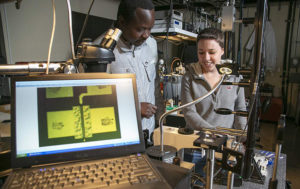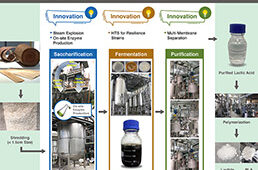 A team led by Tania Betancourt, an associate professor in the Department of Chemistry and Biochemistry at Texas State University, has received a six-year National Science Foundation (NSF) Partnerships for Research and Education in Materials (PREM) grant of nearly $4 million to establish the Center for Intelligent Materials Assembly (CIMA).
A team led by Tania Betancourt, an associate professor in the Department of Chemistry and Biochemistry at Texas State University, has received a six-year National Science Foundation (NSF) Partnerships for Research and Education in Materials (PREM) grant of nearly $4 million to establish the Center for Intelligent Materials Assembly (CIMA).
The PREM CIMA is a research and education partnership between Texas State and The University of Texas at Austin (UT) Center for Dynamics and Control of Materials (CDCM), an NSF Materials Research Science and Engineering Center (MRSEC). The Texas State team is composed of nine faculty from the Department of Chemistry and Biochemistry and the Department of Physics.
“The program is going to really open the doors for quite a number of students from the College of Science and Engineering to get involved in research, which will enlighten them on the applicability of what they’re learning in the classroom to real life problems that we’re trying to address in the area of materials for biomedical, energy, electronic and environmental applications,” Betancourt said.
U.S. Sen. John Cornyn and U.S. Rep. Lloyd Doggett voiced their support for the new research center.
“Investing in Texas higher education will provide our students with invaluable skills and resources now and keep Texas’ economy strong in the future,” said Sen. Cornyn. “I applaud this announcement and will continue to do everything I can to help students at Texas State University.”
“These funds will ensure students at Texas State and the University of Texas have more opportunities to contribute to groundbreaking research,” said Rep. Doggett. “The solutions of tomorrow will be found by students of today. And with Central Texas a leader in innovation, many of those solutions will be found here.”
“The main idea is to allow students to see their own potential as scientists and engineers,” Betancourt said. “By feeling that they’re part of this research community, our hope is that they will stay engaged and be successful in their classes, graduate and pursue graduate degrees in the field. “PREM CIMA will promote recruitment, retention and degree attainment of a diverse student cohort with a pathway into advanced degrees and careers in materials science. The partnership will conduct research in areas of reconfigurable soft materials and nanostructure control to develop advanced materials for applications including biomedicine, water purification, chemical fuel generation from renewable energy sources and nanoelectronics. Participating students will experience high impact research, mentorship by Texas State and UT faculty, professional development and a supportive community.
“A focus on diversity of students, faculty and partners — paired with the revitalization of under-resourced research — is the foundation of PREM and has been the source of many successful outcomes,” said Debasis Majumdar, director of the NSF PREM program. “It expands national innovation capacity and a much needed, highly trained and diverse workforce, propelling U.S. leadership in STEM fields.”
A key element of increasing pipeline representation will be early recruitment of first- and second-year STEM majors to become PREM Associates. Students will develop confidence and a materials science identity through effective mentorship, research engagement and community development. Retention will be augmented by the student transition to a PREM Researcher status where career development workshops, exposure to top-tier research environments and presentation and publication of research results will prepare students for interdisciplinary materials careers following degree attainment as PREM Graduates.
The grant, supported by NSF’s Division of Materials Research, is designed to foster a materials research partnership between a minority-serving institution and a large-scale research facility. The PREM pathway encourages a diverse cohort of young scientists and engineers to stay in materials research through graduation and move on to pursue higher education and rewarding careers in the field. The new class of awardees will receive support for six years —one year longer than previous awardees.
Since its launch in 2004, PREM has successfully diversified research faculty while improving the likelihood that participating students will go on to complete a doctorate in materials research. The initiative has yielded a wide range of results with applications from potential cancer treatments to novel solar cells. Since its inception, PREM has trained 109 postdocs and graduated 427 graduate students and 793 undergraduate students, most from underrepresented minority groups.





Tell Us What You Think!